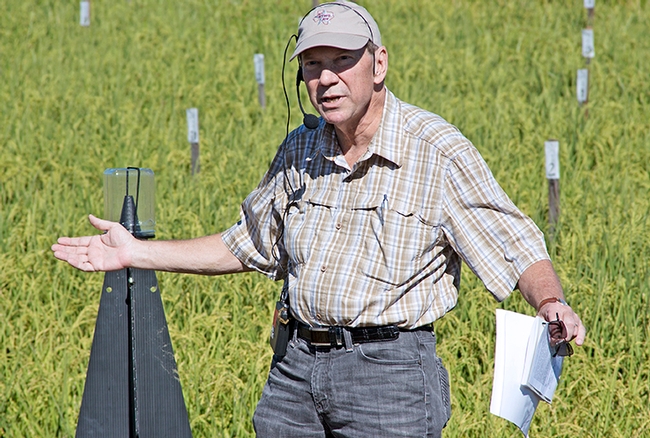- Author: Kathy Keatley Garvey

Cooperative Extension agricultural specialist Ian Grettenberger, assistant professor, UC Davis Department of Entomology and Nematology, and his graduate student, Madison "Madi" Hendrick, will discuss the crops, the pests, and the natural enemies or beneficials at a virtual Facebook live session from 11 a.m. to noon, Thursday, Oct 22.
The event, "The Good and the Bad: Insects and Other Arthropods in Agriculture, with a Focus on California Rice and Alfalfa," will be live-streamed on the UC Davis Bohart Museum of Entomology's Facebook page. (Link to Facebook live here). Grettenberger and Hendrick will present short talks and then field questions. No personal Facebook account is required to join the session, which is free and open to the public.
"This is all about the arthropods, both the pests and beneficials that they study in the rice and alfalfa fields," said Tabatha Yang, education and outreach coordinator for the Bohart Museum of Entomology. "Most of the focus is on insects, but tadpole shrimp in rice fields also will be discussed." A virtual family craft activity is also planned.
"I will be discussing some of the insect (or arthropod) problems faced by growers of rice in California and some of the challenges in managing them, Grettenberger said. "In rice, some of the key arthropod pests are tadpole shrimp, which can turn what would have been a lush stand if rice into a poor stand with a lot of floating seedlings. Meanwhile, later in the year, armyworm caterpillars, the larvae of a moth, can chew on rice leaves and destroy plants. I'll discuss some of the ongoing work to better understand and manage these pests."
Grettenberg's fields of expertise include field and vegetable crops; integrated pest management; applied insect ecology, and biological control of pests. (See Spotlight on Ian Grettenberger.) Among his current grants:
- Protection of rice from invertebrate pests
- Insecticide resistant alfalfa weevils in the western United States: Quantifying the scope of resistance and implementing a plan to manage the threat?
- Management of key cotton arthropod pests with insecticides and acaricides, a proactive approach to prepare for the invasion of the tomato leafminer (Tuta absoluta) into California
- Detection, biology and control of the exotic Swede midge (Contarinia nasturtii) for California cole crops
- Management of the western spotted and striped cucumber beetle in melon production
- Biological control of the bagrada bug
- Insecticide resistance monitoring and evaluation of efficacy of current chemical tactics for managing aphids and thrips in lettuce
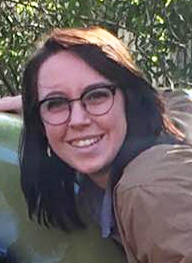
What sparked his interest in entomology? "I had biologist parents, and was drawn into entomology at a pretty young age," Grettenberger said. "I spent plenty of time looking in flowers and turning over logs looking for insects. Once I started thinking about going to graduate school for entomology, I decided to focus on the intersection of agricultural entomology and insect ecology. I wanted to work on applied issues in entomology."
Hendrick, a second-year graduate student in the Grettenberger lab, received her bachelor's degree in iInternational studies at North Carolina State University, and also spent a semester at Nagoya University in Japan (she minored in Japanese).
"I got my start in entomology completely by chance!," Hendrick related. "I needed a science credit and happened to pick a class called 'Insects and People.”' That class really helped me to reframe the way I thought about insects and appreciate what interesting little critters they are. Through that class, I was also able to get a job as an undergraduate assistant in an entomology lab. I worked in a specialty crops lab, where I developed interests in integrated pest management and invasive species. I now study insecticide resistance in the alfalfa weevil, and I'm excited to share what I've learned through this outreach event!"
Grettenberger, Yolo County Farm Advisor Rachael Freeman Long and Madi Hendrick recently wrote a piece in the UC Agricultural and Natural Resources (UC ANR) blog, Alfalfa and Forage News, "A (Virtual )Update on Worms, Weevils an Aphids in Alfalfa."
"This year, the Kearney Research and Extension Center Alfalfa and Forage Field Day went virtual," Grettenberger wrote. "Attendees did not get the chance to look out over lush fields of alfalfa or towering plantings of sorghum, but they get did an update on ongoing work in alfalfa and other forages. Our team put together a rapid-fire video to discuss what are typically the key insect pests in California alfalfa: summer worms, alfalfa weevils, and aphids."
The summer worms in alfalfa include the summer worms: Western yellowstriped armyworm, beet armyworm and alfalfa caterpillar. Another key pest is the alfalfa weevil. The trio also discussed aphids and their natural enemies, including lady beetles, aka ladybugs).
Pests of rice include armyworms, aster leafhoppers, crayfish, rice leafminers, rice seed midges, rice water weevils and tadpole shrimp.
The Bohart Museum, directed by Lynn Kimsey, UC Davis professor of entomology, is located in Room 1124 of the Academic Surge Building on Crocker Lane, UC Davis campus, but is temporarily closed. The museum houses nearly eight million insect specimens; a live "petting zoo" of Madagascar hissing cockroaches, walking sticks and taranatulas; and a gift shop stocked with insect-themed T-shirts, books, posters, jewelry, candy and insect-collecting equipment.
More information on the Bohart Museum's virtual presentation is available on its website or by contacting Yang at tabyang@ucdavis.edu.
Resources:
- Alfalfa and Forage News: A (Virtual) Update on Worms, Weevils and Aphids in Alfalfa (By Ian Grettenberger, Rachael Freeman Long and Madi Hendrick, Sept. 20, 2020) (See video on same page)
- Alfalfa and Forage News: Natural Enemies Are Important for Control of the Aphid Complex in Alfalfa--A Case Study (By Ian Grettenberger, Rachael Freeman Long, Daniel Putnam and Rob Wilson, April 7, 2020)
- UC Statewide Integrated Pest Management Program: How to Manage Pests of Alfalfa
- UC Statewide Integrated Pest Management Program: Insects and Other Pests of Rice
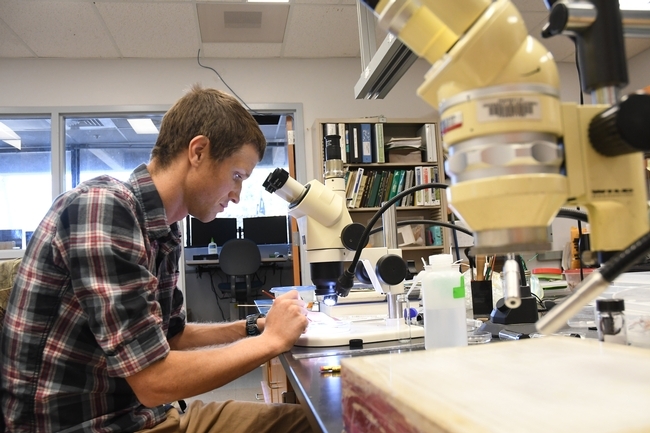
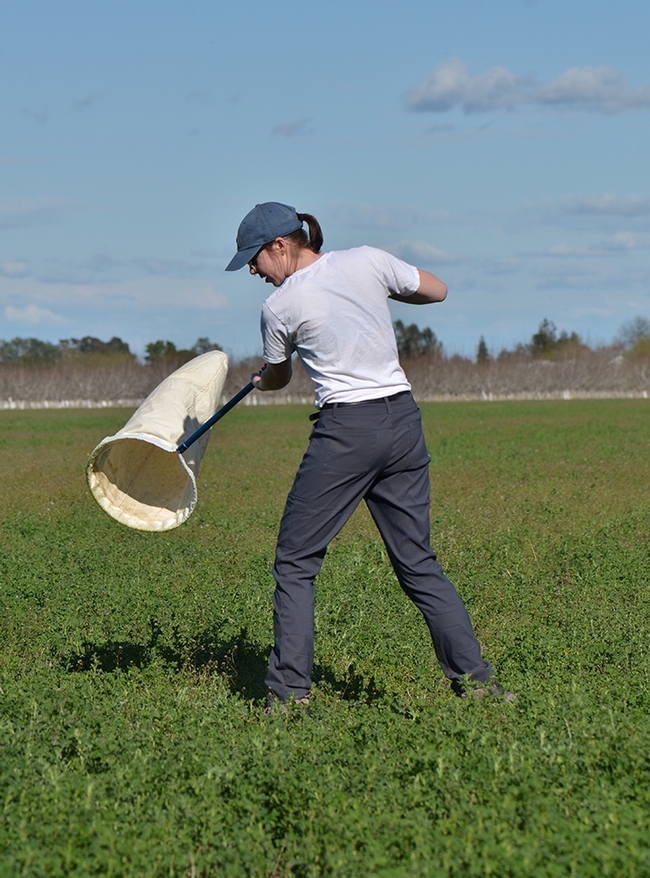
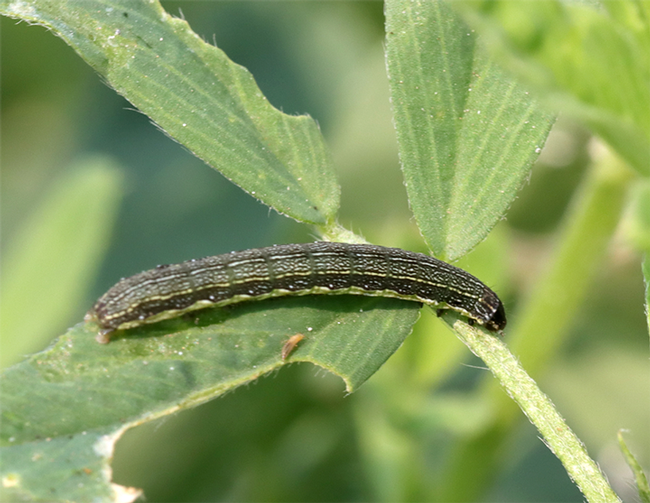
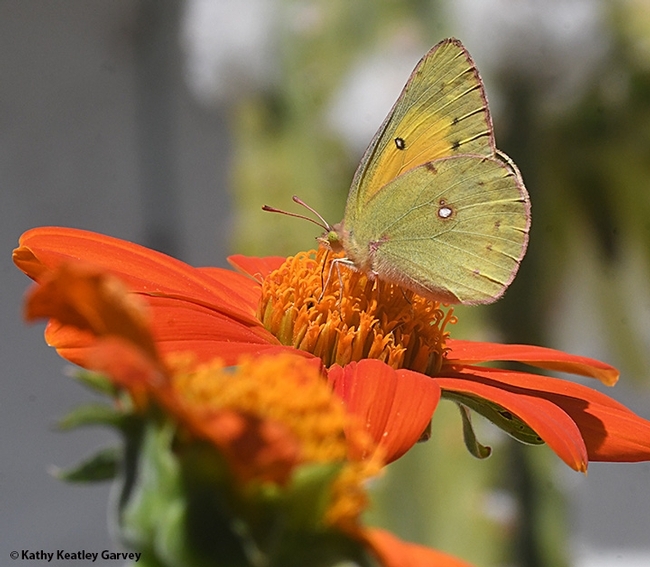
- Author: Kathy Keatley Garvey
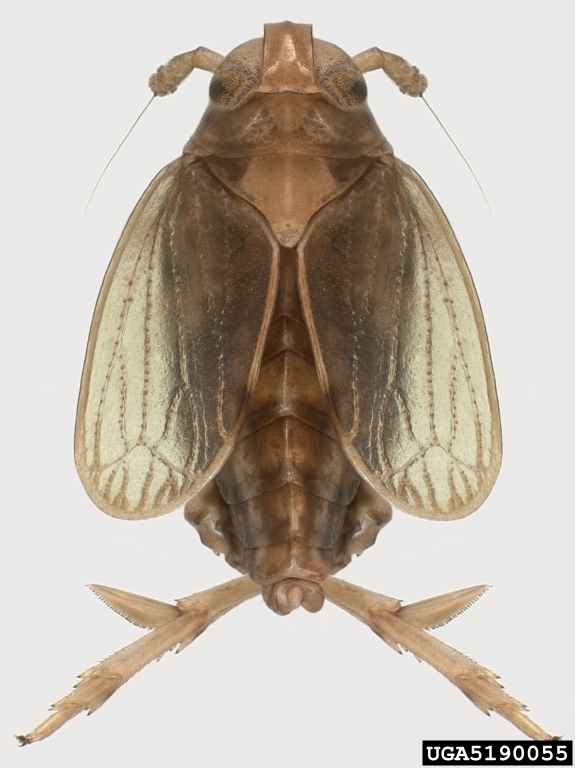
First-of-its-kind research, published in Scientific Reports of the journal Nature by a nine-member team, including UC Davis agricultural entomologist Christian Nansen, indicated that attracting alternative hosts to parasitoids of rice insect pests, can help protect a rice crop. The players: a grass species, a planthopper, and an egg parasitoid.
The field and laboratory work, done in China, targeted the brown planthopper, Nilaparvata lugens, or BPH, the economically most important rice pest in Asia. Results showed that BPH densities were “significantly lower in the rice fields with the banker plant system compared to control rice fields without banker plant system,” the scientists said.
“Many people are familiar with the concept of a ‘trap crop'-- a sacrificial crop which is planted mixed in with or adjacent to an economically important crop and the trap crop serves to manipulate pests away by offering them a more attractive/suitable host alternative,” said Nansen, an assistant professor with the UC Davis Department of Entomology and Nematology. “The use of banker plants in pest management is similar to the use of trap crops, but banker plants typically have multiple ecological functions.”
The researchers planted a grass species, Leersia sayanuka, next to rice. It attracted a planthopper (Nilaparvata muiri), which does not infest rice.

Rice is the stable food of more than 50 percent of the global population, and 60 percent of the Chinese population. However, scientists concur that the world's rice production needs to increase drastically over the next three decades to meet the growing food demand in Asia. Growing concern over BPH outbreaks and higher pesticide usage led to the sustainable pest management study.
Titled “Use of Banker Plant System for Sustainable Management of the Most Important Insect Pest in Rice Fields in China,” the research is unique in that it is the first published study describing the attraction of alternative hosts to parasitoids of rice insect pests. In rice systems, previously published research involved planting sesame as a nectar source to promote the establishment and persistence of a predatory bug; and studies involving parasitoids.
BPH, found only in southeast Asia and Australia, feeds on the rice crop at all stages of plant growth and can also transmit two viruses, rice ragged stunt virus, and rice grassy stunt virus. Damage can commonly result in a 60 percent yield loss. An infestation is often called “hopper burn,” referring to yellow patches that soon turn brown.
Although BPH is not found in the United States, this kind of study “may be an approach to consider in California in the future if insecticide resistance continues to impeded effective insect control,” Nansen said.
Noting the importance of the banker plant system, Nansen said that banker plants “involve promotion of plant diversity to enhance pest self-regulatory ecosystem functions, such as predation and competition, to reduce susceptibility of agricultural crops to native and invasive pests. Also, banker plants “may provide resources, such as shelter, pollen and nectar or alternative preys to improve the establishment and persistence of beneficial insect populations used to control a specific pest.”
The first successful banker plant system, developed in 1977, involved tomato as the banker plant, a parasitoid and a whitefly.
Nansen is affiliated with both UC Davis and the Zhejiang Sustainable Pest and Disease Control, Institute of Plant Protection and Microbiology, Zhejiang Academy of Agricultural Sciences, Hangzhou, China.
Co-authors of the research paper include lead author Zhongxian Lu and colleagues Xusong Zheng, Yanhui Lu, Junce Tian, Hongxing Xu, all of the Zhejiang Sustainable Pest and Disease Control; and Pingyang Zhu, Facheng Zhang and Guihua Chen of the Jinhua (China) Plant Protection Station.
The study was jointly supported by the National Key Research and Development Program of China, Zhejiang Key Research and Development Program, and the Special Fund for Agro-scientific Research in the Public Interest.
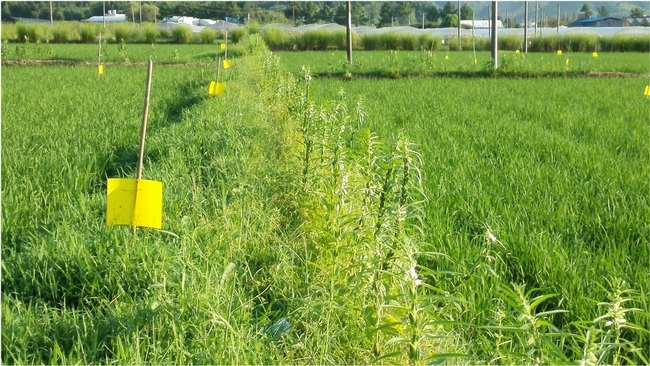
- Author: Kathy Keatley Garvey

Dr. Godfrey was internationally acclaimed for his research on rice and cotton. He was heavily involved in developing IPM to maintain the sustainability of California agriculture, seeking “to reduce the ‘footprint' of agriculture on the environment and society, and to advance the science of entomology and applied insect ecology.”
At UC Davis, he taught arthropod pest management and agricultural entomology. He developed IPM strategies for not only rice and cotton but for such field and vegetable crops as alfalfa, dry beans, timothy grass, melons, mint and onions.
A member of the entomology department since April 1991, Dr. Godfrey served as its vice chair in 2008, and also that year, as president of the Pacific Branch, Entomological Society of America.
“Larry was an outstanding contributor to the department, not only as a researcher and teacher, but also in the effective ways that he connected with clientele through outreach,” said Steve Nadler, professor and chair of the UC Davis Department of Entomology and Nematology. “He was a member of our department's Executive Committee and I could always count on Larry for sound advice.”
“Being the two Davis faculty with agricultural entomology extension duties, Larry and I shared a lot over the last 25 years and he was my closest colleague in our department when he passed today,” said Extension entomologist and distinguished professor Frank Zalom, an IPM specialist and a past president of the Entomological Society of America. “I've always respected him for being quiet and humble despite his many accomplishments. He filled the shoes of several faculty members who retired before he came to Davis and he did his job exceptionally well. It's hard for me to imagine not having him nearby as the go-to entomologist for field crops, although his research, extension, and, most importantly his graduate students, will serve as his legacy for years to come.”
Said professor Jay Rosenheim: “Larry was a researcher who always placed the farmer's needs first. This is why he was so highly valued by California's growers of rice, alfalfa, cotton, and vegetable crops, and why his research program grew and grew over his years at Davis. He was also an excellent communicator, and epitomized the role of researcher/educator in the Land-Grant system. Despite his illness, he continued to work tirelessly on his pest management research, refusing to compromise on his commitments. His dedication to our profession was truly remarkable.”
Yolo County Farm Advisor Rachael Long, who collaborated with Dr. Godfrey on dry bean research, said: “He was an incredibly dedicated field crop entomologist and terrific colleague with team spirit, and his loss leaves a big hole in our lives and I'll miss him.”
“What I admired about Larry was his stoicism,” said former graduate student Mohammad-Amir Aghaee, now a postdoctoral fellow at North Carolina State University. “Nothing seemed to wear down his resolve.”
Dr. Godfrey, born July 7, 1956, grew up on an Indiana farm, and was a 1974 graduate of Salem (Ind.) High School. He received two entomology degrees from Purdue University, West Layfayette: his bachelor's degree in 1978 and his master's degree in 1980. He earned his doctorate in entomology in 1984 from the University of Kentucky, Lexington, studying with major professor Kenneth Yeargan. He was a member of Phi Beta Kappa, Phi Kappa Phi, Sigma Xi and Gamma Sigma Delta.
Said Yeargan: "As I stated in my letter of recommendation for Larry many years ago when he applied for the position at UC Davis, Larry was an outstanding 'synthesizer' of information. He had a knack for looking at a problem, thinking through all the ramifications, and coming up with logical, practical ways to approach the problem – and usually finding a solution. He will be missed by many." It was at the University of Kentucky where Larry met his wife-to-be, Kris Elvin, then a postdoctoral scholar.
Dr. Godfrey began his career as a product development specialist for Union Carbide Agricultural Products Co., Inc., Research Triangle, N.C., before joining the University of Nebraska's Department of Entomology from July 1987 to March 1991 as a research associate.
“Growing up on a farm in Indiana, I saw first-hand the ‘battles' that farmers and homeowners face trying to produce crops and grow landscape plants in competition with insects,” Dr. Godfrey recalled in an earlier interview. “I became fascinated with insects through the typical ‘bug-in-a-jar' hobby. A county Natural Resources Field Day cultivated my interest in entomology and this led to enrollment in the 4-H entomology project. By the time I was several years into the 4-H project, I was transporting a dozen wooden collection boxes full of pinned insects to the county fair.”
“My first summer job involved surveying for Japanese beetles as they progressed across Indiana. This was an invasive insect in the Midwest in the mid-1970s; this same insect is of serious concern now in California an invasive pest that could damage many crops—such as grapes—and ornamentals—such as roses.”
Dr. Godfrey was one of 24 founding members of the California Invasive Species Advisory Committee, appointed by then Secretary A.G. Kawamura of the California Department of Food and Agriculture, to recommend “ways to mitigate non-native species' effects on resources throughout the state.” The goal: to protect California's environment, food systems, human health and economy from invasive and destructive pests, plants and diseases.
At UC Davis, Dr. Godfrey zeroed in on invasive insect and mite pests such as silverleaf whitefly, panicle rice mite, and rice water weevil. In addition, he targeted scores of pests, including alfalfa weevils, blue alfalfa aphids, spotted cucumber beetles, and two-spotted spider mites. He researched plant response to insect injury, refining economic thresholds.He also researched various pest management tactics, including biological control, reduced risk insecticides, mating disruption, cultural control, and host plant resistance.
Highly respected by his peers, Dr. Godfrey received the Excellence in IPM Award in 2005 from the Pacific Branch, Entomological Society of America (PBESA), followed by the PBESA Distinguished Achievement Award in Extension in 2010. Nationally, he was elected chair of ESA's Section F (crop protection) in 2002.
For many years, he served as the advisor to the UC Davis Linnaean Games teams, which won regional (PBESA) and national (ESA) championships in college-bowl type competitions involving insect questions. He himself was on the championship 1983 University of Kentucky team, the second annual Linnaean Games in the North Central Branch of ESA “where it all started,” he said. “It was a few years before the other branches started this competition and several years before they did it at the national meeting.”
As part of his Extension work, Dr. Godfrey wrote publications, regularly met with growers, and delivered scientific talks at workshops. He addressed the annual California Rice Field Day for 25 years and also spoke at alfalfa IPM workshops, among others. He was a subject editor for the Journal of Cotton Science and the Journal of Integrated Pest Management. In addition, Dr. Godfrey served on many departmental, college and UC Agriculture and Natural Resources committees.
Funeral services will be held Saturday, April 29 in Salem, Ind., where he grew up. In lieu of flowers, the family asks for donations to pet rescue groups or groups that support young people interested in entomology or agriculture. A memorial and celebration of his life will take place at UC Davis in the near future.
He is survived by his wife, Kris Godfrey; his mother, Laura Godfrey; and sister, Carol Green and family. He was preceded in death by his father, Don Godfrey.
